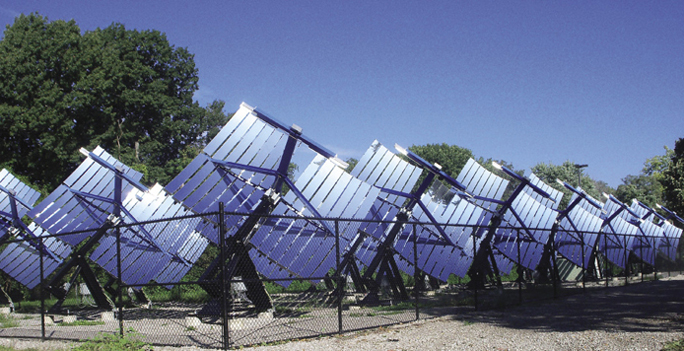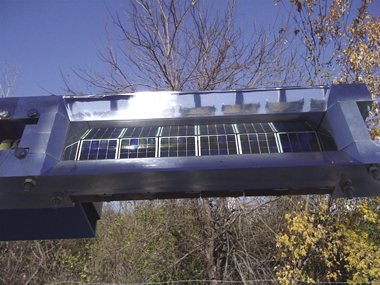
Efficient Cells Cut the Cost of Solar Power
NASA Technology
If you visit Glenn Research Center, you might encounter a photovoltaic (PV) array that looks unlike anything you’ve ever seen. In fact, what one would normally identify as the panel is actually a series of curved mirrors called solar concentrators, engineered to reflect sunlight rather than absorb it.
These concentrators gather, intensify, and focus sun beams upward, aiming at a fixture containing specialized silicon concentrated PV chips—the actual solar cells. If you stay by the array for a while, you’ll notice that the solar concentrators follow the path of the sun throughout the day, changing position to best capture and utilize the sunlight.
The specialized chips that make the technology possible are the brainchild of Bernard Sater, an engineer who had worked at Glenn since the early 1960s before retiring to pursue his unique ideas for harnessing solar power. Sater contributed to multiple PV projects in the latter part of his career at the Center, including research and development on the International Space Station’s solar arrays. In his spare time, he enjoyed tinkering with new approaches to solar power—experiments that resulted in the system installed at Glenn today.
Sater’s basic idea had two components. First, he wanted to create a silicon cell that was smaller, more efficient, and much lower cost than those available at the time. To ensure that the potential of such a chip could be realized, he also planned on pairing it with a system that could concentrate sunlight and focus it directly on the cell.
When he retired from Glenn in 1994 to focus on researching and developing the technology full time, Sater found that NASA was interested in the concept and ready to provide funding, facilities, and expertise in order to assist in its development.
Technology Transfer
Sater’s first set of Space Act Agreements with Glenn resulted in the development of what is today the PhotoVolt cell: a silicon chip many times smaller than those employed in conventional solar technology—each array of miniature cells is about the size of a thumb nail. At the time, no standards existed to test high intensity solar cells, so Sater worked with NASA scientists to develop test methods in Glenn’s world-class facilities.
All the while, Sater’s progress was supported by his son, Neil. Although Neil was employed at Intel at the time, he worked with his father in his spare time to develop the technology. With PhotoVolt in place, Neil and Bernard became convinced that it was time to move toward commercialization. Says Neil, “What we decided in 2007, when I decided to go full time, is that we needed to develop the whole solution. We had this chip, so next we needed a concentrator that the chips could go in.”
The two formed Oberlin, Ohio-based GreenField Solar Inc. and began assembling a team and raising money—all while continuing to develop the technology under ongoing Space Act Agreements with Glenn. Their solar concentrator concept soon became the StarGen system, which features parabolically shaped mirrors designed for use with the PhotoVolt cell.
The partnership between Greenfield Solar and Glenn has reaped rewards for both parties. NASA has received access to the unique chip, which has played a role in multiple space missions, and GreenField Solar has refined its solar concentrator system. “The facilities and expertise at Glenn have been essential to solving numerous technical issues,” says Neil.
In 2008, Glenn purchased and installed two StarGen solar concentrators for research and testing, as well as to demonstrate the cutting-edge solar technology at the Cleveland facility. Roshanak Hakimzadeh, deputy chief technologist at Glenn, points to GreenField Solar as an example of how beneficial the Agency’s partnerships can be for everyone involved. “GreenField Solar’s founders were able to work closely with experts in the field at Glenn, which contributed to the success of the company. This technology represents a successful partnership between NASA and the commercial sector.”
Benefits
Whereas conventional solar cells lay flat and passively collect sunlight, the StarGen solar concentrators ensure that the PhotoVolt cells receive as much intensified light as possible, all day. Between the sunlight being intensified by mirrors—hundreds of times stronger than normal—and the efficiency of the PhotoVolt cell, Neil says that the StarGen system is able to provide about 200 times more power than conventional panels for a given amount of silicon.
Bernard says it’s the smaller size of the PhotoVolt cell that reduces costs and gives GreenField Solar its competitive edge. “The majority of the market is large panels of silicon. The problem is that silicon is relatively expensive, especially compared to glass. So we take all of that silicon and shrink it down to just a little chip, and then we concentrate the light so that we produce more power using much less silicon.”
The intensity of the system produces an excess of thermal energy, which Neil says can be put to creative secondary uses. At Glenn, for example, NASA originally planned on using that energy to heat a nearby conference room. And currently on another site, a greenhouse stationed next to the panels is being kept warm with the superfluous heat.
Solar power may be a renewable, clean, zero-emission energy source, but it still occupies only a small portion of the total market for energy. Neil sees GreenField Solar’s technology as having the potential to change that in the long run by making solar power less expensive even than fossil fuels and nuclear power. “Our mission is to move solar into mainstream deployment. When you drive around, you rarely see solar panels—in fact, you really notice them when you see them, because they’re so rare. We want to make them ubiquitous.”
After spending many years developing the technology, in large part through its partnership with NASA, GreenField Solar is now making its system commercially available in 2012. The company is also focusing globally, with strong connections in Asia. While the technology itself was developed by the company, Neil emphasizes that NASA’s support was essential to their success in bringing it to the point of commercialization.
“Right now we have 30 employees, and it’ll be a lot higher in the future,” he says. “Essentially, these jobs exist because of NASA’s investment in this technology. We wouldn’t have been able to raise the funds we’ve raised or position ourselves the way we have without NASA’s support.”
PhotoVolt™ is a registered trademark of GreenField Solar.
StarGen™ is a registered trademark of GreenField Solar.

GreenField Solar’s concentrators produce an excess of thermal heat that can be used for secondary purposes, such as heating nearby buildings or even greenhouses.

PhotoVolt cells can generate grid-scale solar power at a lower cost per kilowatt-hour than most existing PV systems.

GreenField Solar’s StarGen system uses a tracking system to follow the path of the sun, which the parabolic mirrors concentrate into a small area. The system is approximately 20 percent more efficient than conventional solar panels.













